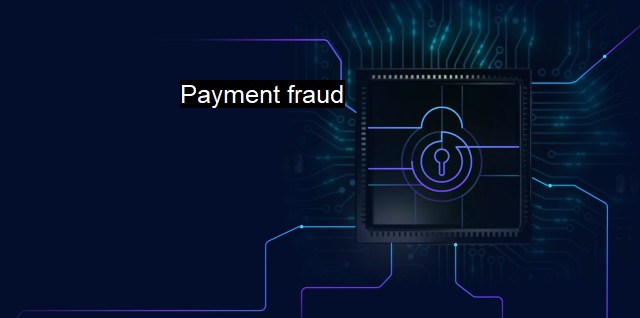What is Payment fraud?
Preventing Payment Fraud: Strategies for Combating Cybercriminals' Sophisticated Techniques in Digital Transactions
Payment fraud continues to stay relevant as one of the noticeable threats in the cybersecurity landscape. Although the dynamics of cybersecurity can be hard to comprehend, it is vital to understand these terms if parties are to safeguard individual finances and businesses. At its core, payment fraud is any unauthorized transaction that occurs on a debit or credit card. This can materialize in multiple forms, with perpetrators using both advanced technology and traditional scamming techniques to exploit victims and numerous unsuspecting individuals or corporations.Payment fraud is often associated with identity theft. Typically, the cybercriminal discovers or unofficially receives personal information, such as bank account details or credit card numbers, and uses this data to make illegal transactions. Consequently, an entity discovers sudden expenses on their card statement that weren't committed by them, which provides significant clarity for recognizing payment fraud.
Voiced in a broader perspective of cybersecurity, payment fraud technically falls under the umbrella of financial crime and draws its principles from broader cyber threats. Here, cybercriminals or hackers implement similar hostile methodologies like malware, phishing and social engineering. Remarkably, every transaction that hosts information transfer between two parties attracts potential threats from hackers.
Implementation of DDoS attacks elements, Remote Access Trojans, Ransomware, or malicious bots surfaces as prime methods for data exploitation in modern cyber threats. Malvertising, which is a fraudulent technique of online advertising to distribute malware, also situates as a potential danger. All these sophisticated techniques primarily drive towards one goal - financial theft. This portrays how contemporary payment fraud extends beyond simple identity theft.
Online platforms serve as a core tool for supporting these frauds, which gained prominence with the rise of e-commerce and digital banking. Online auctions, peer-to-peer transactions, undelivered merchandise, misrepresentation of products or services, and internet access service scams consistently infiltrate several transactions. Contrarily, payment fraud isn’t confined wholly to an online setting, it may surface during offline transactions as well.
To combat payment fraud, cybersecurity measures should be enforced. Installing a reliable antivirus solution proves to be an effective countermeasure for malware threats. It helps by detecting and removing any malware to prevent information extraction that possibly leads to fraud. Using a firewall also safeguards by blocking unauthorized access.
Multifactor authentication (MFA) provides another robust layer of data security; MFA elevates standard protocols by requiring additional layers of authentically approved information for guaranteeing authenticity. Using updated software that hosts the capacity to betoken any cyber threats from harmfully executing or for supporting encrypted data transmission is also crucial for cybersecurity.
It is also crucial for entities to imbibe a mindset prioritising cybersecurity. Remaining diligent and alert for any suspicious activity or anomalies with app behavior forms one aspect of this proactive outlook. Consistently conducting cybersecurity training for employees helps businesses identify scams, phishing attempts and suspicious emails, consequently deterring payment fraud.
Payment fraud injects considerable chaos into a transactional framework that should ideally be secure and predictable. The enormity of control that a hacker wields upon cyber space poses significant threat traces in consumer data dealings. As businesses increasingly move towards a digital-first environment and embrace advanced technology such as AI and IoT, the question of cybersecurity gains escalating importance. Thus, awareness about payment fraud must permeate transactional cultures to sidestep monetary loss and reputational damage. While robust cybersecurity measures battle these highly destructive cyber threats, it's essential to understand that identifying payment fraud commences from proactive surveillance and the smart application of existing protective tools to defend against potential cyber threats.

Payment fraud FAQs
What is payment fraud?
Payment fraud is any fraudulent activity that is committed across a payment platform or process. This can include stolen credit cards, phishing scams, and identity theft.What are some common types of payment fraud?
Some common types of payment fraud include stolen credit cards, identity theft, phishing scams, and SMS phishing (smishing) scams.How can I protect myself from payment fraud?
One way to protect yourself from payment fraud is to keep your antivirus software up to date and use secure payment platforms. You can also monitor your bank accounts regularly to ensure that no unauthorized transactions have taken place.What should I do if I suspect payment fraud?
If you suspect payment fraud, you should contact your bank or credit card company immediately. They will be able to help you freeze your accounts, investigate the potential fraud, and help you recover any lost funds. It’s also a good idea to report the fraud to the appropriate authorities, such as the Federal Trade Commission or your local police department.| | A | | | B | | | C | | | D | | | E | | | F | | | G | | | H | | | I | | | J | | | K | | | L | | | M | |
| | N | | | O | | | P | | | Q | | | R | | | S | | | T | | | U | | | V | | | W | | | X | | | Y | | | Z | |
| | 1 | | | 2 | | | 3 | | | 4 | | | 7 | | | 8 | | |||||||